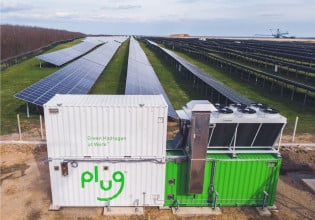Advanced Energy Lab Aims to Double Datacenter Energy Efficiency
Cummins, McKinstry and Microsoft have unveiled their new Advanced Energy Lab. The 20-rack datacenter pilot, located at the McKinstry Innovation Center in the Sodo neighborhood of Seattle, is now operational and will soon deliver data and insights on how fuel cells can perform in this environment.
Research suggests that the integration of fuel cells directly into the datacenter can nearly double the energy efficiency, while also reducing costs and bringing additional benefits to the grid at large.
Washington Governor Jay Inslee officially launched the pilot with formal remarks and a "cord cutting" event to represent the project's independence from the traditional electrical grid. Executives from Microsoft, Cummins, McKinstry and Siemens were and other guests were present and toured the new datacenter facility.
The Advanced Energy Lab was conceived and funded by the three partners, with additional funding provided by Siemens and the Washington State Department of Commerce, via its Clean Energy Fund.
"The Lab is our latest step towards our ongoing work to eventually eliminate the energy and resource impact of our datacenters; in other words, making our datacenters disappear," said Suresh Kumar, Corporate Vice President, Cloud Infrastructure and Operations, Microsoft.
Cummins provided additional funding for the project. "This project is another example of how we are committed to developing a wide variety of power technologies to bring our customers the choice and solutions that enable their success today and in the future," said Jennifer Rumsey, Vice President and Chief Technical Officer, Cummins.
"We're excited to be working with fantastic companies like Microsoft and McKinstry on such a potentially important project. All of the partners are committed to achieving our company goals through technological innovation and environmental stewardship," concluded Rumsey.
McKinstry provided the facilities, as well as the engineering and construction services for the pilot. "It has been a pleasure to have partners like Microsoft and Cummins on this awesome project. The type of collaboration and partnership demonstrated throughout this effort is exactly what the construction industry needs to design and build efficient and innovative buildings," said Dean Allen, Chief Executive Officer, McKinstry.
Currently, datacenters are powered by the electrical grid, with electrons flowing from a power plant, through multiple substations and transmission lines, before finally being converted into the right voltage for datacenters to use.
By powering in-rack fuel cells directly from a natural gas line, or potentially a renewable power source on site, the Advanced Energy Lab's revolutionary design significantly streamlines the process of energy transmission and reduces the energy loss that occurs along the way.
According to a posting on the Microsoft Green Blog, "This stark and simple design significantly reduces the amount of energy lost in power generation, transmission, and power conversion. Right now, datacenters are powered by the electrical grid, which flows from a power plant, through multiple substations and transmission lines, and then must be converted into the right voltage for a datacenter before we can use it.
"With fuel cells powered directly from the natural gas line, we cut out all those steps, and remove the energy losses that occur through this long transmission process as seen below:
"With fewer pieces in the supply chain, there are fewer potential points of failure. That helps improve the reliability of our power supply and our datacenters. And, of course, with this simplification comes a reduction in cost. Eliminating electrical distribution, power conditioning, and backup infrastructure makes a datacenter easier and less expensive to build, operate and manage.
We started this journey with a desire to push the boundaries of what could be done with innovative energy technology in a datacenter environment. Most fuel cell implementations seen today are parallel to the grid, or an alternate source of grid power. But we opted to start from a blank sheet of paper and engineered from the server out, cutting out the unnecessary electrical equipment and even the electrical grid.
"Starting in 2013, we developed a partnership with the National Fuel Cell Research Center at the University of California Irvine, where we first tested the idea of in-rack fuel cells. Then, in our Cheyenne pilot project in 2014, we demonstrated how fuel cells are not dependent on clean natural gas, but could work in a datacenter environment on a renewable fuel—biogas.
"Why is the world's leading cloud services company tinkering with the datacenters that power the cloud? Our commitment to innovation is part of Microsoft's culture. This innovation is aligned with our strategy to minimize resource impact, use our resources more efficiently, and reduce embedded carbon and water in all our assets, while driving energy efficiency. That is how we ‘make the datacenter disappear,' all while still providing world-class Microsoft Cloud Services.
"This Advanced Energy Lab brings together everything we have learned so far. It moves the fuel cell concept off the test bench to an actual datacenter, so we can learn in a real environment. To be sure, there's still more work to do, like finishing the Lab and beginning testing and delivering results. But we're excited about the potential of the Lab to change how others think about energy and datacenters - and then beyond Tech.
"This work could also pay dividends for other large consumers of energy, such as electric utilities, who are increasingly tasked with bringing more energy into cities, despite the challenge of limited space for more electrical lines. And we're continuing to investigate ways to reuse all waste products - for example, the heat from fuel cells and servers could be used to power a cooling system, or to generate more power," the Blog concluded.







